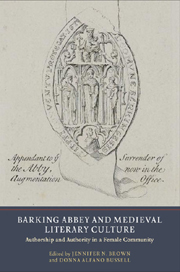Book contents
- Frontmatter
- Contents
- List of Contributors
- Acknowledgements
- List of Abbreviations
- Dedication
- Introduction: Barking's Lives, the Abbey and its Abbesses
- I BARKING ABBEY AND ITS ANGLO-SAXON CONTEXT
- II BARKING ABBEY AND ITS ANGLO-NORMAN CONTEXT
- III BARKING ABBEY AND THE LATER MIDDLE AGES
- Afterword. Barking and the Historiography of Female Community
- Bibliography
- Index
- YORK MEDIEVAL PRESS: PUBLICATIONS
Afterword. Barking and the Historiography of Female Community
Published online by Cambridge University Press: 05 April 2013
- Frontmatter
- Contents
- List of Contributors
- Acknowledgements
- List of Abbreviations
- Dedication
- Introduction: Barking's Lives, the Abbey and its Abbesses
- I BARKING ABBEY AND ITS ANGLO-SAXON CONTEXT
- II BARKING ABBEY AND ITS ANGLO-NORMAN CONTEXT
- III BARKING ABBEY AND THE LATER MIDDLE AGES
- Afterword. Barking and the Historiography of Female Community
- Bibliography
- Index
- YORK MEDIEVAL PRESS: PUBLICATIONS
Summary
When the borough of Barking celebrated its accession to charter status in 1931, the local civic authorities produced a pageant of Barking Abbey's history. The pageant's script-writer was Colonel E. A. Loftus (d. 1987), then headmaster of Barking Abbey school, the first co-educational grammar school in England. Loftus tells the abbey's history in eight scenes, from the Roman camp on the site to the abbey's dissolution in 1539. By scene 6, William the Conqueror is staying at the nunnery in the first year of his English conquest, while he strengthens the Tower of London and receives promises of loyalty from English lords. Barking's abbess Ælfgifu is not shown as joining other lords in making these promises, though she is rewarded for her hospitality by William's promise that ‘no house for holy women shall be greater in all the land’. Scene 7, a single, wordless pageant scene, bridges the four centuries between 1066 and 1539: together with Adelidis (or Adeliza), abbess of Barking 1136–73, King Stephen and Queen Matilda and their attendants return from hunting in the forest where the abbess of Barking had sporting rights. Scene 8 is a pageant of Dorothy Barley (abbess 1527–39) surrendering to the king's commissioner, William Petre, as the nuns sing the ‘Barking’ hymn, O gloriosa virginum, for the last time.
- Type
- Chapter
- Information
- Barking Abbey and Medieval Literary CultureAuthorship and Authority in a Female Community, pp. 283 - 296Publisher: Boydell & BrewerPrint publication year: 2012



